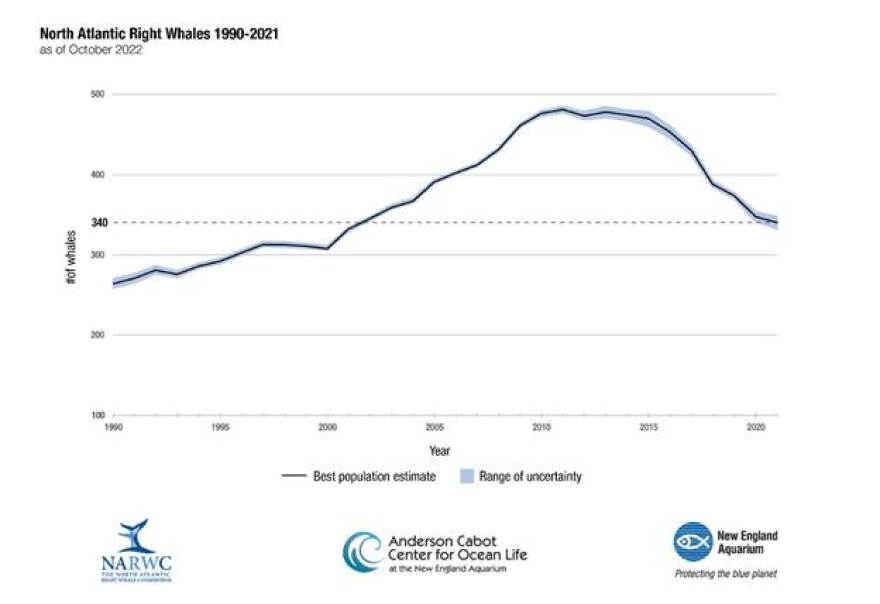The population of critically endangered North Atlantic right whales has fallen again, this time to an estimated 340, scientists say.
The 2021 population estimate is down from an estimated 348 the previous year, according to the North Atlantic Right Whale Consortium, which announced the news today, ahead of its annual meeting.
The latest estimate of 340 includes a modeling range of +/- 7 right whales.
Heather Pettis, a research scientist at the New England Aquarium and executive administrator of the Consortium, said the species has been drawing closer to extinction every year for the past decade, and this latest population estimate is discouraging.
“We are at a point with this species where we have a limited amount of time to turn things around,” Pettis said. “There's some point that you get to in a species where recovery is exceptionally challenging, which it is right now. But it only gets more challenging, the more animals that we remove from the population.”
The reproduction rate for the critically endangered species has remained low as entanglements in rope and fishing gear and collisions with boats have proven to be the leading causes of death for the animals. The so-called “vessel strikes” can leave right whales suffering from blunt force trauma and deep cuts, often from propellers.
“What we've seen over the last two decades is, simply put, mortality caused by humans is outpacing reproduction in the species,” Pettis said.

According to the report, 18 calves were born in 2021, which is well below the average of 24 calves per year produced in the 2000s. The population estimate for 2022 won’t be released until next October, but already scientists are concerned that just 15 calves were born this year. In addition, at least one whale was stuck by a boat and 10 were entangled in fishing gear in 2022.
No whales have been found dead in 2022, but scientists believe most right whale deaths go undocumented, considering the whales’ extensive range from their feeding grounds off the coast of the northeastern United States and Canada down to calving grounds in the warm waters off South Carolina, Georgia, and Florida.
“There has been a lot of focus on the fact that no right whale mortalities have been detected in 2022, which is certainly a good thing” said Dr. Scott Kraus, chair of the Consortium. “While we can be cautiously optimistic about this, we know that only one-third of right whale deaths are observed, so it is likely that some whales have died this year that were not observed. Additionally, we continue to see unsustainable levels of human-caused injuries to right whales. A lot of work by many stakeholders has gone into protecting these whales, but the hard truth is it hasn’t been enough.”
Hope for stabilization
However, the report contained one bright spot.
“The good news,” Pettis said, “is that [the decline] wasn't as dramatic as we've seen in the last few years. And so that certainly gives us hope that we may be seeing the floor of this decline.”
Scientists have been closely tracking the whales’ population since 1990. The worst year-to-year change came in 2017, when the population estimate was 430. In 2018, it dropped to 388 — a decrease of nearly 10 percent.
In fact, with this new population estimate, the species number is now roughly equal to what it was around 2001.
“In the ensuing decade, the population increased by 150 whales,” said Philip Hamilton, senior scientist at the New England Aquarium and the identification database curator for the Consortium. “That tells us this species can recover if we stop injuring and killing them.”
Pettis said she has some hope for population stabilization in part because federal and state officials have imposed stricter limits on lobstermen and other fisheries whose gear has historically been found to cause entanglements.
Seasonal fishing closures, the required use of rope that breaks more easily when a whale gets entangled, and experimentation with so-called “ropeless” fishing gear could help the whales make a comeback.
All of those conservation efforts have created tension between right whale advocates and lobstermen, who say the strict rules are putting them out of business. Lobster fishing groups often point fingers at other fisheries for entangling the whales.
The latest population numbers represent another difficult chapter in a long history for North Atlantic right whales, which were named during the whaling period that began in the 1700s because their high fat content caused them to float quickly after death, making them the “right” whales to kill.
“Human impacts have to be reduced,” Pettis said. “If that happens — when that happens — the whales know what to do. They will find food. They will find each other. They will reproduce.”
Copyright 2022 CAI. To see more, visit CAI. 9(MDAxMzY2MjQ0MDEyMzcyMDQ5MzBhZWU5NA001))


